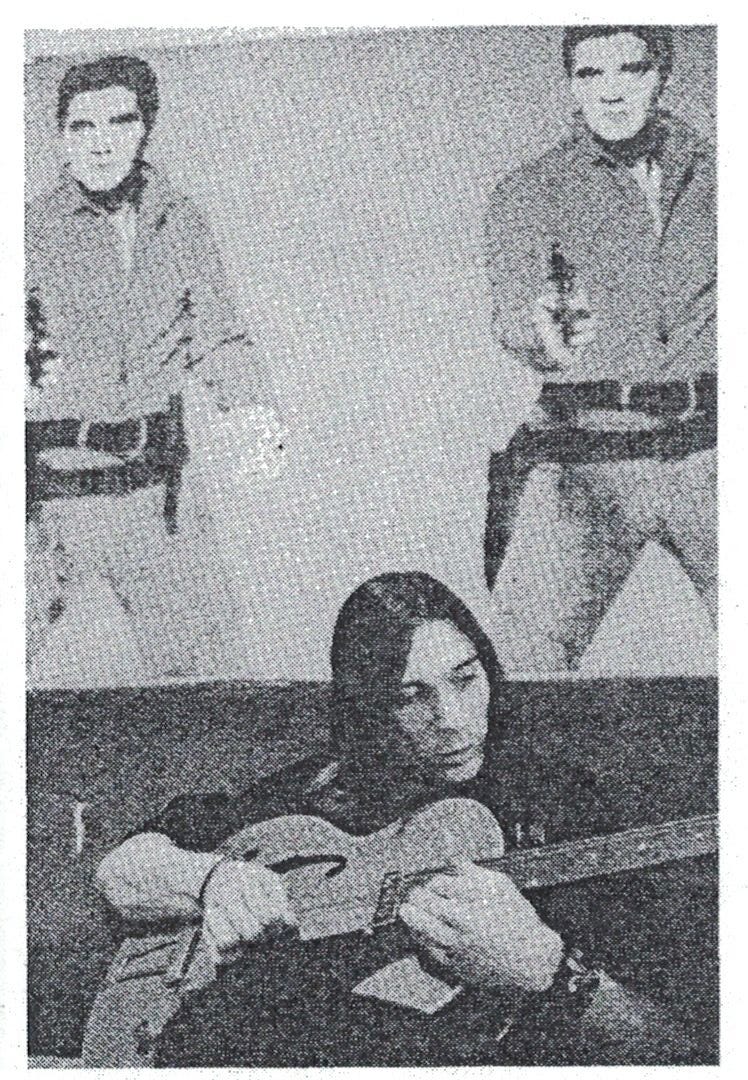The 'Days Between Stations' columns, Interview magazine 1992-2008: John Cale, Bubblegum Rocker?
November 2000
Columbia Legacy will soon reissue John Cale's 1970 Vintage Violence, his first solo album. The record disappeared in its time; it didn't make pop sense. Those few who heard it have never really gotten it out of their heads.
On the cover, Cale appeared in what looked like a plasticine mask melting off his impassive face. It was in fact a nylon stocking pulled over his head, but the basic ax-murderer look seemed to be the point—a later album showed Cale performing on stage in full Jason-style hockey mask.
The cover art fit the legend Cale was already building. Arriving from Wales to burrow into the farthest corners of the New York avant-garde, in the early and mid-'60s setting Guinness Book of World Records standards with marathon-drone sessions as part of La Monte Young and his Theatre of Eternal Music's Dream Syndicate assemblage, the Cale of Vintage Violence had, as a public artist, made one thing happen: the end of the Velvet Underground's "Heroin."
In the cacophony of Cale's viola and Lou Reed's feedback screeching at each other, you could feel the drug fighting off the blood. You could hear the fact of what was being described fighting off the pretense of any mere piece of art to match its absolute. But for all of the pure pop cool Lou Reed gave the song's last line "And I guess/That I just don't know"—everything that established Reed's right to end the song, everything that had already taken it past where any pop fan could have expected the song to end, came from Cale. Listen now to Inside the Dream Syndicate Volume 1: Day of Niagara (1965), recently released on Table of the Elements and credited to Cale, Tony Conrad, Angus Maclise (the Velvet Underground's first drummer), La Monte Young, and Marian Zazeela. In the thirty-one minutes of severe, scratching, calming frequency modulation, you hear not that the avant-garde with which Cale began was diminished when its tricks were applied to pop music, but that pop music was where the tricks of the avant-garde were turned into a real language. "What I had learned first about John Cale," Tony Conrad writes for Inside the Dream Syndicate, "was that he had written a piece which pushed a piano down a mine shaft." On Inside the Dream Syndicate the musicians carry the piano to the entrance of the mine and leave it there, realizing Cale's intentions conceptually; in "Heroin" the musicians enter the mine and pull the piano down on top of themselves.
So that was John Cale in 1970, and to a good degree that has been John Cale ever since.
That the best music on Vintage Violence was bubblegum—often Gothic bubblegum, but bubblegum nonetheless—set the album outside the Cale story as it was taking shape, and there is no story into which the album fits today.
"Cleo" and "Adelaide" are the 1910 Fruitgum Co.'s "Simon Says," "1, 2, 3, Red Light," and "Goody Goody Gumdrops"; they're Ohio Express' "Yummy Yummy Yummy" and "Chewy Chewy." The high note that opens "Cleo" is teenage yearning caught in a single, naked sound, the sound of a breath caught in the throat: "Oh!" is all it says, and all it needs to say. The chirpy girl chorus is less robust all-American bubblegum than its decadent European sister, French ye-ye. There's a cute little guitar solo that starts up for no reason and goes nowhere, but the bright Beatles riff it never bothers to finish can stay in your head for days, torturing you because you just can't remember where you heard it.
Somehow, that girl singer seems like the key. Along with the sound of American Top 40, Vintage Violence is alive with the sound of old-world ruins. In the languid pace Cale gives "Please," as if daring the steel guitar to play even more slowly than he's singing, you can almost see the old abbeys and castles crumbling, the paint flaking off the ancestor portraits, the stones falling to the ground. All across the record, especially with "Gideon's Bible" and "Ghost Story," there's the sense of a man abandoning things of consequence and meaning—abandoning the damning significance of all things European for the liberating triviality of an American tune.
Cale can't help but sound European; he's never sounded more so. But that's where the pathos is: the attempt of a man who carries dead languages within himself to empty himself, to fulfill none of the hopes others have invested in him.
Originally published in Interview Magazine, November 2000



I first bought VINTAGE VIOLENCE in the mid-'80s, as a Velvets-fanatical college student, and it made virtually no impression on me - played it a couple of times, filed it away, eventually sold it. When the Columbia Legacy CD reissue came out I tried again, and immediately fell in love with it. Always nice when that happens. Of Cale's many other albums, only PARIS 1919 is more beloved by me, and only a smidgen more at that.
Ah so that is where The Dream Syndicate got their name from!